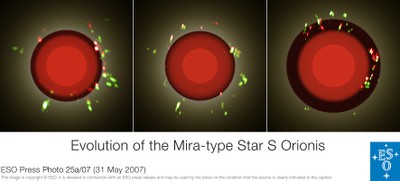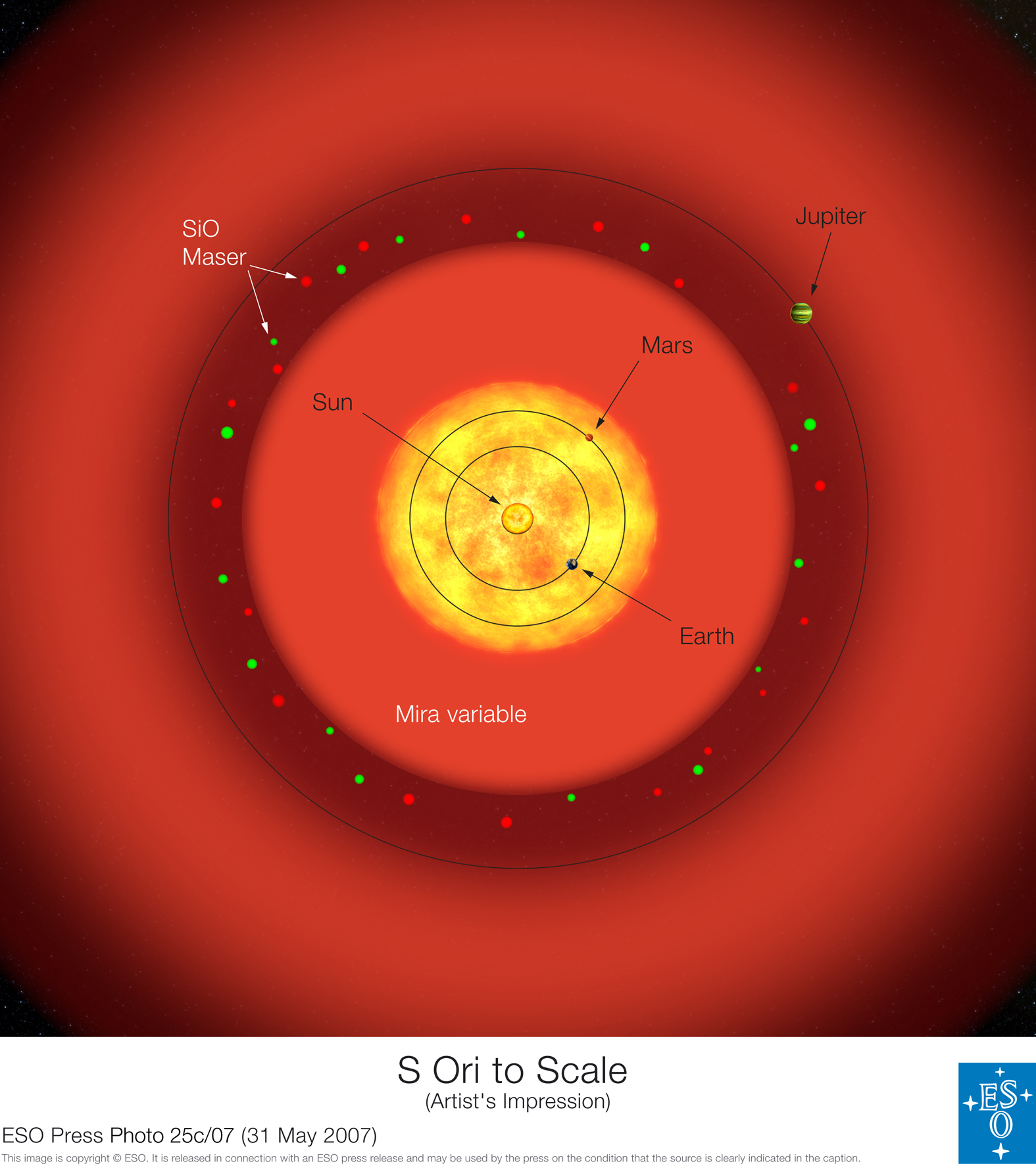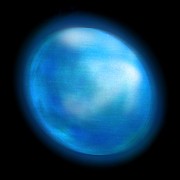Beobachtungen eines alten Roten Riesen mit Großteleskopen zeigt überraschende Details
1. Meldung:
ESO 25/07 - Science Release
31 May 2007
For Immediate Release
Chronicle of a Death Foretold
Two of the World's Largest Interferometric Facilities Team-up to Study a Red Giant Star
Using ESO's VLTI on Cerro Paranal and the VLBA facility operated by NRAO, an international team of astronomers has made what is arguably the most detailed study of the environment of a pulsating red giant star. They performed, for the first time, a series of coordinated observations of three separate layers within the star's tenuous outer envelope: the molecular shell, the dust shell, and the maser shell, leading to significant progress in our understanding of the mechanism of how, before dying, evolved stars lose mass and return it to the interstellar medium.
S Orionis (S Ori) belongs to the class of Mira-type variable stars. It is a solar-mass star that, as will be the fate of our Sun in 5 billion years, is nearing its gloomy end as a white dwarf. Mira stars are very large and lose huge amounts of matter. Every year, S Ori ejects as much as the equivalent of Earth's mass into the cosmos.

ESO PR Photo 25a/07
Evolution of the Mira-type
Star S Orionis
The three images show different epochs in the evolution of the red star S Orionis. The red and blue spots result from the radio emission of the maser shell. The radio observation is overlapped to the simultaneous infrared detection: indeed the red disc indicates the stellar surface and the molecular layers, while the green shades represent the location of the dust shell. The first two images are obtained close to the stellar minimum luminosity, when most of the dust is produced. The third image is taken just after the visual maximum, when the dust shell already expanded. The study was made using ESO's VLTI on Cerro Paranal and the VLBA facility operated by NRAO. (c) ESO
"Because we are all stardust, studying the phases in the life of a star when processed matter is sent back to the interstellar medium to be used for the next generation of stars, planets... and humans, is very important," said Markus Wittkowski, lead author of the paper reporting the results. A star such as the Sun will lose between a third and half of its mass during the Mira phase.
S Ori pulsates with a period of 420 days. In the course of its cycle, it changes its brightness by a factor of the order of 500, while its diameter varies by about 20%.
Although such stars are enormous - they are typically larger than the current Sun by a factor of a few hundred, i.e. they encompass the orbit of the Earth around the Sun - they are also distant and to peer into their deep envelopes requires very high resolution. This can only be achieved with interferometric techniques.

ESO PR Photo 25b/07
Structure of S Ori
(Artist's Impression)
Sketch of the structure of a pulsating red giant, as derived by the recent interferometric study on S Orionis. The environment around the parent star is made up by three main components: a molecular shell (inner red layer), a dust shell (outer red layer) and a maser shell (red and green speckles). Grains of aluminum oxide constitute most of the dust shell (observed in the infrared band), while the maser radio emission comes from silicon monoxide molecules. The maser spots velocities indicates that the gas is expanding, at a speed of about 10 km/s. (c) ESO
"Astronomers are like medical doctors, who use various instruments to examine different parts of the human body," said co-author David Boboltz. "While the mouth can be checked with a simple light, a stethoscope is required to listen to the heart beat. Similarly the heart of the star can be observed in the optical, the molecular and dust layers can be studied in the infrared and the maser emission can be probed with radio instruments. Only the combination of the three gives us a more complete picture of the star and its envelope."
The maser emission comes from silicon monoxide (SiO) molecules and can be used to image and track the motion of gas clouds in the stellar envelope roughly 10 times the size of the Sun.
The astronomers observed S Ori with two of the largest interferometric facilities available: the ESO Very Large Telescope Interferometer (VLTI) at Paranal, observing in the near- and mid-infrared, and the NRAO-operated Very Long Baseline Array (VLBA), that takes measurements in the radio wave domain.
Because the star's luminosity changes periodically, the astronomers observed it simultaneously with both instruments, at several different epochs. The first epoch occurred close to the stellar minimum luminosity and the last just after the maximum on the next cycle.
The astronomers found the star's diameter to vary between 7.9 milliarcseconds and 9.7 milliarcseconds. At the distance of S Ori, this corresponds to a change of the radius from about 1.9 to 2.3 times the distance between the Earth and the Sun, or between 400 and 500 solar radii!
As if such sizes were not enough, the inner dust shell is found to be about twice as big. The maser spots, which also form at about twice the radius of the star, show the typical structure of partial to full rings with a clumpy distribution. Their velocities indicate that the gas is expanding radially, moving away at a speed of about 10 km/s.
The multi-wavelength analysis indicates that near the minimum there is more dust production and mass ejection: in these phases indeed the amount of dust is significantly higher than in the others. After this intense matter production and ejection the star continues its pulsation and when it reaches the maximum luminosity, it displays a much more expanded dust shell. This clearly supports a strong connection between the Mira pulsation and the dust production and expulsion.
Furthermore, the astronomers found that grains of aluminum oxide - also called corundum - constitute most of S Ori's dust shell: the grain size is estimated to be of the order of 10 millionths of a centimetre, that is one thousand times smaller than the diameter of a human hair.
"We know one chapter of the secret life of a Mira star, but much more can be learned in the near future, when we add near-infrared interferometry with the AMBER instrument on the VLTI to our (already broad) observational approach," said Wittkowski.
Notes
A maser is the microwave equivalent to a laser, which emits visible light. A maser emits powerful microwave radiation instead and its study requires radio telescopes. An astrophysical maser is a naturally occurring source of stimulated emission that may arise in molecular clouds, comets, planetary atmospheres, stellar atmospheres, or from various conditions in interstellar space.
ESO operates the Very Large Telescope Interferometer at Paranal Observatory, Chile, with four fixed 8.2-m telescopes and four relocatable 1.8-m telescopes, working at optical/infrared wavelengths. NRAO operates the Very Long Baseline Array with 10 stations across the U.S. working at radio wavelengths between 3 mm and 90 cm (0.3-90 GHz). ESO, NRAO and other partners will operate the Atacama Large Millimeter/submillimeter Array (ALMA) in Chile, working at millimetre wavelengths between 0.3 and 10 mm (30-950 GHz).
Contacts
Markus Wittkowski
ESO
Phone: +49 89 3200 6769
Email: mwittkow (at) eso.org
David A. Boboltz
U.S. Naval Observatory, USA
Phone: +1 202 762 1488
Email: dboboltz (at) usno.navy.mil
2. Meldung:
Mit vier zu einem Interferometer zusammengeschalteten Großteleskopen ist die Fototgrafie der Oberfläche des Sterns Atair im Adler gelungen. Er ist 17 Lichtjahre entfernt und 1,2 mal so groß wie usnere Sonne uind rotiert in nur 10 Stunden weshalb er stark abgeplattet erscheint.

Ein Quasar Triplet ist nicht immer ein Gravitationslinseneffekt, Supermassive Schwarze Löcher können durch Wechselwirkung benachbarter Galaxien gleichzeitig aktiv werden!
8 January 2007
For Immediate Release
It Is No Mirage!
Large Telescopes Team Up to Help Astronomers Discover a Trio of Quasars
Using ESO's Very Large Telescope and the W.M. Keck Observatory, astronomers at the Ecole Polytechnique Fédérale de Lausanne in Switzerland and the California Institute of Technology, USA, have discovered what appears to be the first known triplet of quasars. This close trio of supermassive black holes lies about 10.5 billion light-years away towards the Virgo (The Virgin) constellation.
billion = Milliarden
"Quasars are extremely rare objects," says George Djorgovski, from Caltech and leader of the team that made the discovery. "To find two of them so close together is very unlikely if they were randomly distributed in space. To find three is unprecedented."
The findings are being reported at the winter 2007 meeting of the American Astronomical Society in Seattle, USA.
Quasars are extraordinary luminous objects in the distant universe, thought to be powered by supermassive black holes at the heart of galaxies. A single quasar could be a thousand times brighter than an entire galaxy of a hundred billion stars, and yet this remarkable amount of energy originates from a volume smaller than our solar system. About a hundred thousand quasars have been found to date, and among them several tens of close pairs, but this is the first known case of a close triple quasar system.
Quasars (QUAsi StellAR Sources) were first discovered in 1963 by the Dutch-American astronomer Maarten Schmidt at the Palomar Observatory (California, USA) and the name refers to their 'star-like' appearance on the images obtained at that time. Distinguishing them from stars is thus no easy task and discovering a close trio of such objects is even less obvious.
The feat could only be accomplished by combining images from two of the largest ground-based telescopes, ESO's 8.2-m Very Large Telescope at Cerro Paranal, in Chile, and the W. M. Keck Observatory's 10-m telescope atop Mauna Kea, Hawaii, as well as using a very sophisticated and efficient image sharpening method.
The distant quasar LBQS 1429-008 was first discovered in 1989 by an international team of astronomers led by Paul Hewett of the Institute of Astronomy in Cambridge, England. Hewett and his collaborators found a fainter companion to their quasar, and proposed that it was a case of gravitational lensing. According to Einstein's general theory of relativity, if a large mass (such as a big galaxy or a cluster of galaxies) is placed along the line of sight to a distant quasar, the light rays are bent, and an observer on Earth will see two or more close images of the quasar as a cosmic mirage. The first such gravitational lens was discovered in 1979, and hundreds of cases are now known. However, several groups over the past several years cast doubts that this system is a gravitational lens, and proposed instead that it is a close physical pair of quasars.
What the Caltech-Swiss team has found is that there is a third, even fainter quasar associated with the previously known two. The three quasars have the same redshift, hence, are at the same distance from us.
The astronomers performed an extensive theoretical modeling, trying to explain the observed geometry of the three images as a consequence of gravitational lensing. "We just could not reproduce the data," says Frédéric Courbin of Lausanne. "It is essentially impossible to account for what we see using reasonable gravitational lensing models."
Moreover, there is no trace of a possible lensing galaxy, which would be needed if the system were a gravitational lens. The team has also documented small, but significant differences in the properties of the three quasars. These are much easier to understand if the three quasars are physically distinct objects, rather than gravitational lensing mirages. Combining all these pieces of evidence effectively eliminated lensing as a possible explanation.
"We were left with an even more exciting possibility that this is an actual triple quasar," says Georges Meylan, also from Lausanne. The three quasars are separated by only about 100,000 to 150,000 light-years, which is about the size of our own Milky Way.
Gravitational lensing can be used to probe the distribution of dark and visible mass in the universe, but quasar pairs -and now a triplet- provide astronomers with a different kind of insight.
"Quasars are believed to be powered by gas falling into supermassive black holes," says Djorgovski. "This process happens very effectively when galaxies collide or merge, and we are observing this system at the time in the cosmic history when such galaxy interactions were at a peak."
If galaxy interactions were responsible for the quasar activity, having two quasars close together would be much more likely than if they were randomly distributed in space. This may explain the unusual abundance of binary quasars, which have been reported by several groups. "In this case, we are lucky to catch a rare situation where quasars are ignited in three interacting galaxies," says Ashish Mahabal, one of the Caltech scientists involved in the study.
Discoveries of more such systems in the future may help astronomers understand better the fundamental relationship between the formation and evolution of galaxies, and the supermassive black holes in their cores, now believed to be common in most large galaxies, our own Milky Way included.
This work is also described in a paper submitted to the Astrophysical Journal Letters. The team is composed of S. George Djorgovski, Ashish Mahabal, and Eilat Glikman of Caltech (USA), Frédéric Courbin, Georges Meylan and Dominique Sluse of the Ecole Polytechnique Fédérale de Lausanne (Switzerland), and David Thompson of the University of Arizona's Large Binocular Telescope Observatory (USA).
Contacts
Georges Meylan
Ecole Polytechnique Fédérale de Lausanne
Phone (Sauverny): +41 22 379 24 25
Phone (Lausanne): +41 21 693 06 44
Email: Diese E-Mail-Adresse ist vor Spambots geschützt! Zur Anzeige muss JavaScript eingeschaltet sein!
S. George Djorgovski
(attending the AAS meeting in Seattle on Jan. 7-8)
Caltech Astronomy, USA
Phone: +1 (626) 395-4415
Email: Diese E-Mail-Adresse ist vor Spambots geschützt! Zur Anzeige muss JavaScript eingeschaltet sein!

